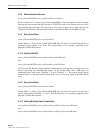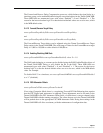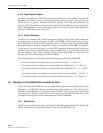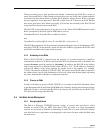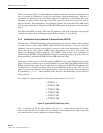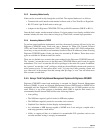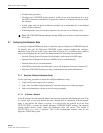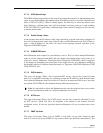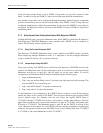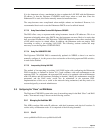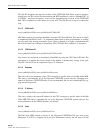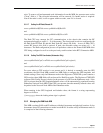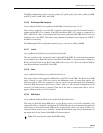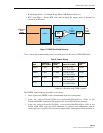
ADCP-75-192 • Issue 2 • June 2007
Page 38
© 2007, ADC Telecommunications, Inc.
script will then prompt “Enter a list of SNMP v2 trap-sinks, one per line: (control-d when
done)” in order to set up any SNMP-V2 trap receivers that traps should be transmitted to.
Any number of trap-sinks can be configured, though the quantity should be kept to a minimum
in order to minimize processor load on network nodes. Also, SNMP V1 and V2 trap-sinks can
configured simultaneously within the same domain. In the event that SNMP-V1 trap-sinks are
configured, the Digivance software will convert the SNMP-V2 traps to SNMP-V1 traps before
transmitting them.
3.7.2 Using Dynamic Host Configuration Protocol With Digivance CXD/NXD
All Hub and RAN nodes, except the Hubmaster node, utilize DHCP to obtain their IP addresses.
Each Digivance CXD/NXD Hubmaster comes standard with a DHCP server to configure its
subnet. The following sections explain its use.
3.7.2.1 Using The Provided Hubmaster DHCP
The Digivance CXD/NXD Hubmaster node comes standard with DHCP already activated.
When employing multiple Hubmaster nodes, it is important to run the configure-hubmaster
script as outlined in Section 10.1 to prevent collisions.
3.7.2.2 Incorporating Existing LAN DHCP
Using a pre-existing LAN DHCP server is ideal when the Digivance CXD/NXD network only
contains one Hubmaster node. In this configuration, there is no need for a router between the
Hubmaster and the rest of the LAN, since all nodes are on the same subnet. To use this
configuration, the Hubmaster DHCP must be disabled using the following steps:
1. Login to Hubmaster node
2. Type “sudo rm /etc/init.d/dhcp3-server” and enter your login password at the prompt. This
stops the DHCP server from being run.
3. Type “sudo killall dhcpd3” to stop the current service.
4. Type “sudo reboot” to reboot the machine.
As the Hubmaster is not configured to be a DHCP client, it requires a static IP that must be
outside the range of the existing LAN DHCP. This may mean narrowing the existing DHCP
server’s address range. For example, take the case where the original DHCP range is
172.20.88.3 through 172.20.88.254 inclusive, and assume it assigns these addresses from the
upper limit towards the lower. Also assume that there’s a router at 172.20.88.1 and another static
IP device at 172.20.88.2. The Hubmaster needs a static IP, but the DHCP is serving all the
“free” addresses in that subnet. To avoid DHCP collisions and the perturbation of preexisting
addresses, the operator would increase the DHCP server’s lower address limit from 172.20.88.3
to 172.20.88.4, and set the Hubmaster to be IP 172.20.88.3.



